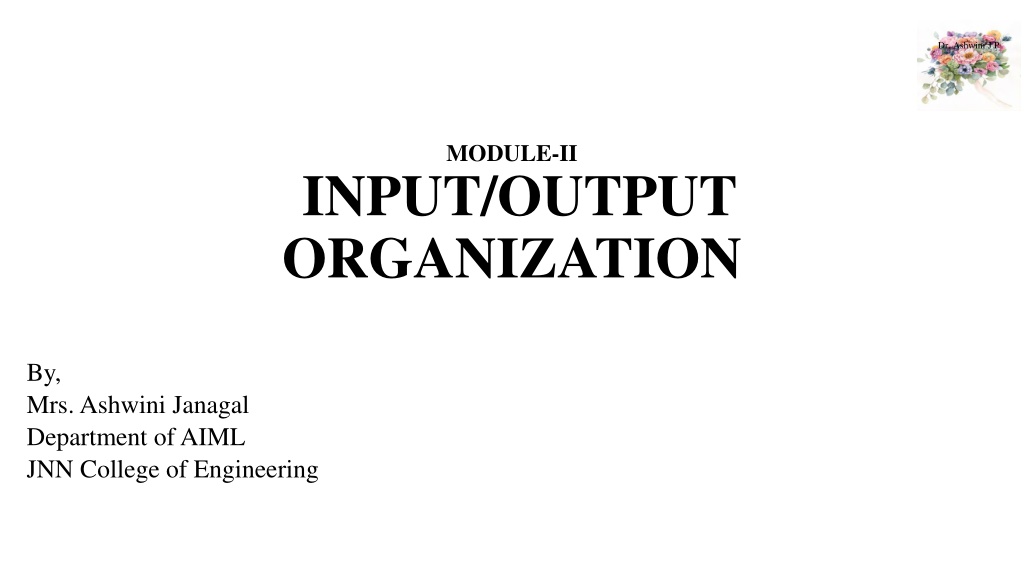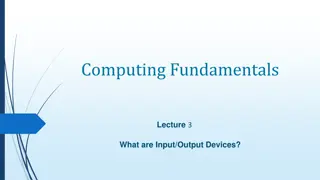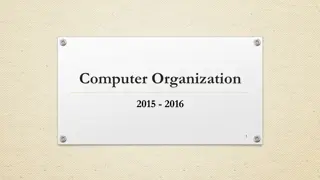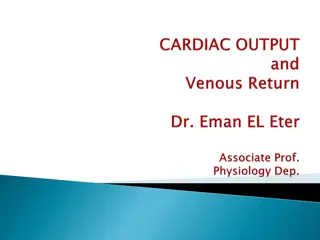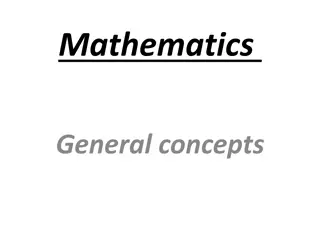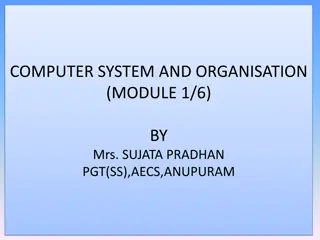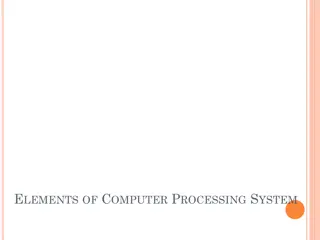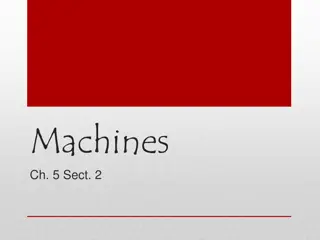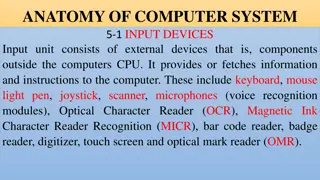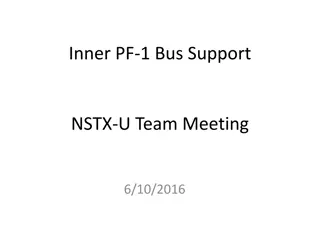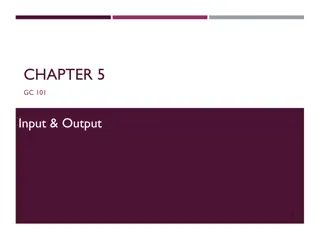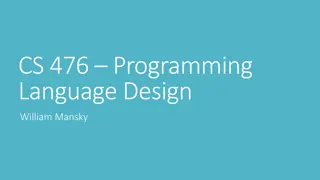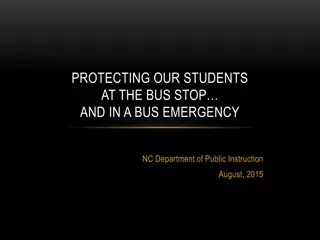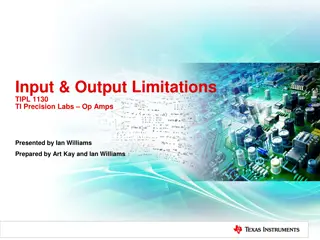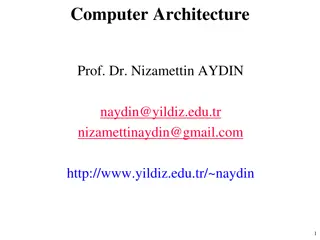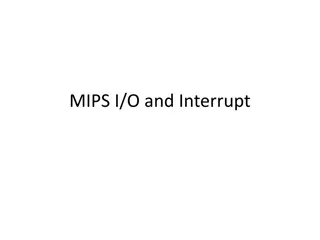Input/Output Organization in Single Bus Architecture
Mrs. Ashwini Janagal, a faculty at JNN College of Engineering, delves into the intricacies of accessing I/O devices, processors, memory, and the architecture of Single Bus. Dr. Ashwini J P also contributes to the discussion on I/O device management and device interfacing.
Download Presentation

Please find below an Image/Link to download the presentation.
The content on the website is provided AS IS for your information and personal use only. It may not be sold, licensed, or shared on other websites without obtaining consent from the author. Download presentation by click this link. If you encounter any issues during the download, it is possible that the publisher has removed the file from their server.
E N D
Presentation Transcript
Dr. Ashwini J P MODULE-II INPUT/OUTPUT ORGANIZATION By, Mrs. Ashwini Janagal Department of AIML JNN College of Engineering
Dr. Ashwini J P ACCESSING I/O DEVICES
ACCESSING I/O DEVICES Dr. Ashwini J P Processor Memory Single Bus Architecture Bus I/O device 1 I/O device n BUS ADDRESS LINES DATA LINES CONTROL LINES
ACCESSING I/O DEVICES Dr. Ashwini J P BUS ADDRESS LINES DATA LINES CONTROL LINES If Processor Wants to Send/Receive any Data from some I/O device........................... FINALLY data transaction will happen on DATA LINE DEVICE will identify its ADDRESS and respond on CONTROL LINE PROCESSOR will keep ADDRESS of the device on ADDRESS LINE PROCESSOR ADDRESS LINES DATA LINES CONTROL LINES
ACCESSING I/O DEVICES Dr. Ashwini J P How do you address I/O devices? BUS I/O ADDRESSING ADDRESS LINES DATA LINES CONTROL LINES I/O and MEMORY with SAME ADDRESS SPACE SEPARATE I/O ADDRESS SPACE 1. Called as MEMORY MAPPED I/O . 2. SAME INSTRUCTIONS to access MEMORY and I/O. 3. Simple. 1. If DATAIN is KEYBOARD REGISTER, LOCA is MEMORY LOCATION. 2. MOVE DATAIN, R0; 3. MOVE LOACA, R1
ACCESSING I/O DEVICES Dr. Ashwini J P How do you address I/O devices? BUS I/O ADDRESSING ADDRESS LINES DATA LINES CONTROL LINES I/O and MEMORY with SAME ADDRESS SPACE SEPARATE I/O ADDRESS SPACE 1. SPECIAL INSTRUCTIONS to transfer data to and from I/O devices. 2. Ex: Some INTEL Versions have separate 16 bit ADDRESS for I/O DEVICES. 3. I/O address lines need not be physically separate from memory address lines.
ACCESSING I/O DEVICES Dr. Ashwini J P Address lines Bus Data lines Control lines Decoding the address sent by Processor to enable device to identify itself. Address Control circuits Data and status registers I/O interface decoder Input device 1. Data register holds the Data Being Transferred -- to or from the processor. 2. Status register holds information necessary for the operation of the I/O device.
ACCESSING I/O DEVICES Dr. Ashwini J P Address lines Bus Data lines Control lines Address Control circuits Data and status registers I/O interface decoder Input device 1. Always remember -- I/O devices are very slow compared to memory and processor. 2. Synchronization is required. 3. Ex: SIN flag in Keyboard STATUS REGISTER. 1. SIN=1, Data (Character) is READY at KEYBOARD REGISTER 2. SIN=0, after DATA is READ FROM PROCESSOR.
ACCESSING I/O DEVICES Dr. Ashwini J P
ACCESSING I/O DEVICES Dr. Ashwini J P STATUS IN and OUT for KEYBOARD AND DISPLAY. DIRQ-> DISPLAY Interrupt Request DEN --> DISPLAY ENABLE KEN --> KEYBOARD ENABLE KIRQ-> KEYBOARD Interrupt Request
Dr. Ashwini J P INTERRUPTS
INTERRUPTS-INTERRUPT HARDWARE Dr. Ashwini J P Three Ways to Access I/O Devices Program Controlled I/O Interrupts Direct Memory Access (DMA)
INTERRUPTS-INTERRUPT HARDWARE Dr. Ashwini J P Three Ways to Access I/O Devices Program Controlled I/O Interrupts Direct Memory Access (DMA)
INTERRUPTS-INTERRUPT HARDWARE Dr. Ashwini J P What is an Interrupt? Answer: A COMMUNICATION SIGNAL to let know that Input/Output device is ready. INTERRUPT REQUEST LINE A BUS CONTROL LINE to send INTERRUPT. INTERRUPT SERVICE ROUTINE A subroutine called in response to INTERRUPT.
INTERRUPTS-INTERRUPT HARDWARE Dr. Ashwini J P EXAMPLE Consider a program consisting of two functions. COMPUTE and PRINT . COMPUTE : Will generate an output of 100 lines. PRINT : Will print the lines. One line at a time. PRINT will send one line and wait for Printer to finish the task. Then Next Line will be sent.
INTERRUPTS-INTERRUPT HARDWARE Dr. Ashwini J P So....What Happens at This Location?
INTERRUPTS-INTERRUPT HARDWARE Dr. Ashwini J P Execution Control has to jump to Interrupt Service Routine Before Branching Store the current values of Program Counter (PC) Processor Registers. Control Flags
INTERRUPTS-INTERRUPT HARDWARE Dr. Ashwini J P Saving and Restoring may be done Automatically Its Time Consuming
INTERRUPTS-INTERRUPT HARDWARE Dr. Ashwini J P Interrupt Latency Time taken from Interrupt Reception to Start of Interrupt Service routine. How do you reduce Latency? 1. Processor Automatically store only minimum information. 2. Rest if necessary user in program has to add extra instructions.
INTERRUPTS-INTERRUPT HARDWARE Dr. Ashwini J P INTERRUPT-HARDWARE There are Multiple I/O Devices Connected. Can they send Interrupts together? How this will be handled? No Interrupt : I/P=Vdd INTR=0 Interrupt From Any Device: I/P=0 INTR=1
INTERRUPTS-INTERRUPT HARDWARE Dr. Ashwini J P INTERRUPT-HARDWARE There are Multiple I/O Devices Connected. Can they send Interrupts together? How this will be handled? WHAT ARE THE ISSUES NOT SOLVED HERE??????
INTERRUPTS-INTERRUPT HARDWARE Dr. Ashwini J P Enabling and Disabling Interrupts 1. What if Processor Doesn t want to be Interrupted? 2. Interrupts can come at any time and change the course of execution. So they need some controlling. 3. Interrupt from keyboard is acceptable only when there is an editor program running.
INTERRUPTS-INTERRUPT HARDWARE Dr. Ashwini J P After receiving Interrupt Signal how does processor let that device know that Wait, I have received your signal ? Interrupt Acknowledgement Signal - Sent by Processor. Start of Data Transfer will let that device know. Why I have to send an acknowledgement?
INTERRUPTS-INTERRUPT HARDWARE Dr. Ashwini J P What if Processor Doesn t want to be Interrupted? When Interrupt Service Routine is Executing ---- Other interrupt should not come.... First Line of Service Routine- Disable Request Line Last Line of Service Routine - Enable Request Line
INTERRUPTS-INTERRUPT HARDWARE Dr. Ashwini J P Enabling and Disabling Interrupts 1. Case 1: Interrupt from Single Device Step 1: Keep Interrupt signal high until Processor Accepts it. i.e., until execution of Service Routine Step 2: Signal is high.... should not be considered as another interrupt as it lead to infinite loop. METHOD-1 Step 2.1: Ignore Until Execution of First Line of Service Routine Step 2.2: Disable Interrupt Request Line Step 2.2: Execute remaining service routine Step 2.2: At the end Enable request line
INTERRUPTS-INTERRUPT HARDWARE Dr. Ashwini J P Enabling and Disabling Interrupts 1. Case 1: Interrupt from Single Device Step 1: Keep Interrupt signal high until Processor Accepts it. i.e., until execution of Service Routine Step 2: Signal is high.... should not be considered as another interrupt as it lead to infinite loop. METHOD-2 Step 2.1:Processor Automatically DISABLE the request line
INTERRUPTS-INTERRUPT HARDWARE Dr. Ashwini J P Enabling and Disabling Interrupts 1. Case 1: Interrupt from Single Device HOW TO ENBALE/DISABLE DEVICES? 1. PROCESSOR STATUS REGISTER(PS) : To indicate status of register 2. a. INTERRUPT-ENABLE-BIT in PS register=1, means Interrupt enabled b. INTERRUPT-ENABLE-BIT in PS register=0, means Interrupt Disabled.
INTERRUPTS-INTERRUPT HARDWARE Dr. Ashwini J P Enabling and Disabling Interrupts 1. Case 1: Interrupt from Single Device Edge Triggered Interrupt Request Line: Leading edge of signal Activates Interrupts. Only once INTERRUPTS are registered.
INTERRUPTS-INTERRUPT HARDWARE Dr. Ashwini J P Enabling and Disabling Interrupts 1. Case 1: Interrupt from Single Device SUMMARY 1. Device raises an Interrupt. 2. Processor Interrupts current running program. 3. INTERRUPT DISABLE by changing PS bits. 4. Interrupt Acknowledgement. 5. Interrupt Service Routine is Run 6. INTERRUPT ENABLE
INTERRUPTS-INTERRUPT HARDWARE Dr. Ashwini J P Enabling and Disabling Interrupts 1. Case 2: HANDLING MULTIPLE DEVICES Imagine the devices connected to processor with single shared bus
INTERRUPTS-INTERRUPT HARDWARE Dr. Ashwini J P Enabling and Disabling Interrupts 1. Case 2: HANDLING MULTIPLE DEVICES Imagine the devices connected to processor with single shared bus INTERRUPT HAS COME FROM WHICH DEVICE???????????
INTERRUPTS-INTERRUPT HARDWARE Dr. Ashwini J P Enabling and Disabling Interrupts 1. Case 2: HANDLING MULTIPLE DEVICES Imagine the devices connected to processor with single shared bus WHICH SERVICE ROUTINE TO EXECUTE??????
INTERRUPTS-INTERRUPT HARDWARE Dr. Ashwini J P Enabling and Disabling Interrupts 1. Case 2: HANDLING MULTIPLE DEVICES Imagine the devices connected to processor with single shared bus ALREADY ONE DEVICE INTERRUPT SERVICE ROUTINE IS EXECUTING......SHOULD OTHER DEVICE BE ALLOWD TO SEND INTERRUPT NOW????????
INTERRUPTS-INTERRUPT HARDWARE Dr. Ashwini J P Enabling and Disabling Interrupts 1. Case 2: HANDLING MULTIPLE DEVICES Imagine the devices connected to processor with single shared bus WHAT IF TWO THREE DEVICES SEND INTERRUPT AT SAME TIME?
INTERRUPTS-INTERRUPT HARDWARE Dr. Ashwini J P Enabling and Disabling Interrupts 1. Case 2: HANDLING MULTIPLE DEVICES SIMPLE WAY TO FIND WHICH DEVICE IS HAS SENT INTERRUPT - POLLING 1. CHECK the STATUS register of each device. 2. If IRQ bit is 1, then that device has sent Interrupt. 3. POLL All the devices connected, and in order if IRQ bit=1, then run that devices SERVICE ROUTINE.
INTERRUPTS-INTERRUPT HARDWARE Dr. Ashwini J P Enabling and Disabling Interrupts 1. Case 2: HANDLING MULTIPLE DEVICES VECTORED INTERRUPT 1. Even though POLLING is simple, it wastes lot of time in POLLING. 2. VECTORED INTERRUPT- INTERRUPTING DEVICE will IDENTIFY ITSELF by sending some CODE. 3. PROCESSOR will directly start EXECUTING respective SERVICE ROUTINE
INTERRUPTS-INTERRUPT HARDWARE Dr. Ashwini J P Enabling and Disabling Interrupts 1. Case 2: HANDLING MULTIPLE DEVICES VECTORED INTERRUPT WHAT IS THE CODE SENT??????? 1. Even though POLLING is simple, it wastes lot of time in POLLING. 2. VECTORED INTERRUPT- INTERRUPTING DEVICE will IDENTIFY ITSELF by sending some CODE. 3. PROCESSOR will directly start EXECUTING respective SERVICE ROUTINE
INTERRUPTS-INTERRUPT HARDWARE Dr. Ashwini J P Enabling and Disabling Interrupts 1. Case 2: HANDLING MULTIPLE DEVICES WHAT IS THE CODE SENT??????? VECTORED INTERRUPT 1. Even though POLLING is simple, it wastes lot of time in POLLING. 2. VECTORED INTERRUPT- INTERRUPTING DEVICE will IDENTIFY ITSELF by sending some CODE. MAY BE STARTING ADDRESS OF SERVICE ROUTINE Its size may vary from 4 to 8 bits. 3. PROCESSOR will directly start EXECUTING respective SERVICE ROUTINE
INTERRUPTS-INTERRUPT HARDWARE Dr. Ashwini J P Enabling and Disabling Interrupts 1. Case 2: HANDLING MULTIPLE DEVICES VECTORED INTERRUPT 1. The location pointed by Interrupting device is where STARTING ADDRESS of SERVICE ROUTINE is stored. 2. INTERRUPT VECTOR: Vector of STARTING ADDRESS OF SERVICE ROUTINES.
INTERRUPTS-INTERRUPT HARDWARE Dr. Ashwini J P Enabling and Disabling Interrupts 1. Case 2: HANDLING MULTIPLE DEVICES VECTORED INTERRUPT How is VECTOR code sent ???????
INTERRUPTS-INTERRUPT HARDWARE Dr. Ashwini J P Enabling and Disabling Interrupts 1. Case 2: HANDLING MULTIPLE DEVICES How is VECTOR code sent ??????? VECTORED INTERRUPT 1. DATA BUS is used. 2. DEVICE will RISE INTERRUPT REQUEST 3. DEVICE will WAIT until INTERRUPT ACKNOWLEDGEMENT. 4. DEVICE will SEND the CODE over DATA BUS.
INTERRUPTS-INTERRUPT HARDWARE Dr. Ashwini J P Enabling and Disabling Interrupts 1. Case 2: HANDLING MULTIPLE DEVICES INTERRUPT NESTINBG 1. What if there is an INTERRUPT REQUEST which can t be IGNORED.
INTERRUPTS-INTERRUPT HARDWARE Dr. Ashwini J P Enabling and Disabling Interrupts 1. Case 2: HANDLING MULTIPLE DEVICES INTERRUPT NESTING 1. What if there is an INTERRUPT REQUEST which can t be IGNORED. 2. That means, some I/O devices are not so important so they should not interfere. 3. But some I/O devices are very important and as and when they want their INTERRUPT SIGNAL should be handled.
INTERRUPTS-INTERRUPT HARDWARE Dr. Ashwini J P Enabling and Disabling Interrupts 1. Case 2: HANDLING MULTIPLE DEVICES How to DESIGN THIS???? INTERRUPT NESTINBG 1. What if there is an INTERRUPT REQUEST which can t be IGNORED. 2. That means, some I/O devices are not so important so they should not interfere. 3. But some I/O devices are very important and as and when they want their INTERRUPT SIGNAL should be handled.
INTERRUPTS-INTERRUPT HARDWARE Dr. Ashwini J P Enabling and Disabling Interrupts 1. Case 2: HANDLING MULTIPLE DEVICES INTERRUPT NESTINBG PRIORITY OF PROCESSOR IS PRIORITY OF THE PROCESS IT IS EXECUTING 1. Give a PRIORITY to each device.
INTERRUPTS-INTERRUPT HARDWARE Dr. Ashwini J P Enabling and Disabling Interrupts 1. Case 2: HANDLING MULTIPLE DEVICES INTERRUPT NESTINBG PROCESSOR PRIORITY is a code in PROCESSOR STATUS (PS) REGISTER. 1. Give a PRIORITY to each device.
INTERRUPTS-INTERRUPT HARDWARE Dr. Ashwini J P Enabling and Disabling Interrupts 1. Case 2: HANDLING MULTIPLE DEVICES INTERRUPT NESTINBG We can change PRIORITY using PRIVILEGED INSTRUCTIONS. 1. Give a PRIORITY to each device.
INTERRUPTS-INTERRUPT HARDWARE Dr. Ashwini J P Enabling and Disabling Interrupts 1. Case 2: HANDLING MULTIPLE DEVICES Do you know about PRIVILEGED EXCEPTION INTERRUPT NESTINBG We can change PRIORITY using PRIVILEGED INSTRUCTIONS. 1. Give a PRIORITY to each device.
INTERRUPTS-INTERRUPT HARDWARE Dr. Ashwini J P Enabling and Disabling Interrupts 1. Case 2: HANDLING MULTIPLE DEVICES When an INTERRUPT SERVICE ROUTINE is executing, if another INTERRUPT comes then, i. INTERRUPT REQUEST is from a device with LOWER PRIORIRTY compared to the present one then IGNORE IT. ii. INTERRUPT REQUEST is from a device with HIGHER PRIORIRTY compared to the present one then stop this one and EXECUTE the SERVICE ROUTINE of NEW REQUEST.
INTERRUPTS-INTERRUPT HARDWARE Dr. Ashwini J P Enabling and Disabling Interrupts 1. Case 2: HANDLING MULTIPLE DEVICES
